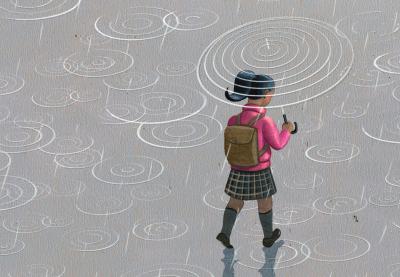Maria Garcia teaches second grade at a dual Spanish-English immersion school in San Francisco’s low-income Bayview neighborhood. Many of the school’s families live on very little; Garcia is accustomed to her students coming to school in the same clothing day after day or complaining of empty stomachs.
Many low-income students take their circumstances in stride, but Garcia knows others aren’t so lucky: Some kids are actually traumatized by daily experiences directly and indirectly related to living in low-income circumstances (unstable housing, food insecurity, loss of utilities, lack of access to health care, school disruption, and exposure to community hardships like theft or violence). That was the case with Luciana.*
Luciana was a transfer student from nearby Oakland. Garcia suspected Luciana might be experiencing poverty-related trauma because she often shared worries about her home life and the family’s constant food shortage. And while she was initially affectionate and talkative with her teacher, over the course of the school year, Luciana’s behavior changed. She spaced out in class and sometimes fell asleep. She stopped participating in group activities. Most significantly, she was no longer open and chatty when Garcia pulled her aside to ask how she was doing.
Fortunately for Luciana, the teachers, counselors and administrators at Garcia’s school had received training that expanded their understanding of trauma to include the potential effects of living in different types of poverty. They engaged a project called UCSF Healthy Environments and Response to Trauma in Schools (HEARTS), co-sponsored by the University of California-San Francisco and San Francisco General Hospital. The goal: to help teachers and administrators understand how all kinds of trauma—including trauma induced by poverty—affect children and their ability to succeed in school. This understanding helps inform classroom-level responses, a critical piece of the puzzle because punitive discipline is not an effective intervention for poor behavior or school performance related to trauma.
Sharon Lacay, a clinical social worker with the HEARTS program, explains the need to extend the scope of trauma response beyond trauma caused by grief, loss or abuse.
“Kids really can’t learn efficiently if they’re anxious or sad—to the point of being traumatized—about where they’re going to live, or whether they’ll have dinner that night,” she says.
Through her participation in HEARTS, Garcia learned that all kids respond to trauma differently: While some students push their frustration and fear outward—lashing out at teachers or classmates—Luciana became withdrawn. “It’s her own, quieter way of dealing with her anxiety related to her living situation,” says Garcia.
Reaching Those in Need
The first step to helping poverty-traumatized kids is identifying them. The outward signs of poor living conditions are obvious in some cases: worn clothing, inadequate hygiene due to lack of electricity or running water, or attempts to sneak lunch food for later. But not all types of poverty look the same, and not every child who appears to be living in poverty is traumatized.
Robin Zorn, 2014 national school counselor of the year, says kids experiencing severe anxiety, sadness or anger over their situation will show a range of symptoms similar to those associated with shock or abuse.
“They may have trouble making friends, since they don’t trust those relationships will last,” says Zorn, who works in Duluth, Georgia.
Lacay adds, “Some traumatized kids act out toward other students or their teacher—an attempt to show that they are in control of those relationships since they aren’t in control of much else in their lives.”
Another telltale sign is hypervigilance. Traumatized kids often startle easily or overreact to minor events. They may also become perfectionists in their schoolwork.
“This is a ‘survival-brain’ type of coping mechanism,” explains Lacay. “The child thinks, ‘If I do everything perfectly, we won’t have to move again, I won’t have to leave this school.’”
Classroom Strategies
Recognizing poverty-induced trauma is only the first step toward making a difference. Garcia knew that children in unstable circumstances could benefit from having trusted adults in their lives, so she began inviting Luciana to special, small-group lunches with her and a few other students. She also connected Luciana with a volunteer school mentor who met with her monthly at lunchtime.
Another arena in which schools can help is access to basic needs. Although technically not the responsibility of the staff, many educators feel compelled to help; one approach is school-level collaborations with community agencies. Zorn helped her school partner with a nearby church to put together weekend food bags for kids in need. Her school also refers parents to organizations that can help them find temporary housing, food vouchers and other services.
Making calls or scheduling meetings with families whenever possible can also help, suggests Monica Dominguez, a school counselor in El Paso, Texas. Opening the lines of communication informs teachers of what they can do at school to better support the student in extenuating circumstances that might otherwise go undetected.
“Maybe a student can’t finish certain assignments because he rarely has electricity for reading at night,” notes Dominguez. “Teachers can work with school officials on special accommodations like extra periods for the student to finish schoolwork or after-school tutoring.”
Young people experiencing trauma also may need some strategies—and spaces—to calm themselves when they’re too anxious to focus on classroom work. Dominguez advocates making peaceful spaces available within each classroom or in another supervised areas of the school. Younger kids benefit from sensory toys like a box filled with rice, simple puzzles and calming music heard through headphones. Older students can journal about their stress and fear, listen to music or practice deep-breathing exercises. Lacay notes that leading classes in simple body stretches or an eyes-closed visualization of a calming scene can take as little as two minutes and benefit all students without singling out those living in particularly tough circumstances.
Adopting a Trauma-Sensitive Lens
At Dominguez’s school, teachers share stories and observations with the school’s Response to Intervention (RTI) committee. Administrators and teachers, along with a social worker, a nurse and Dominguez, collaborate on how best to help poverty-traumatized students. The team brainstorms ways to support students in school and refers children and families to outside counseling when needed.
As for Garcia, she says she’s learned—with the help of her school’s HEARTS counselor—that helping her students manage poverty-related trauma is necessary if she’s going to succeed in teaching them their letters and numbers. But perhaps even more important, she understands that children living with trauma need the support and the confidence of their educational community—often their main emotional resource outside their family.
Dominquez agrees. In addition, she says, when a teacher steps in to help individual students at risk, the entire classroom benefits. “You’ll have a more calm, focused class with fewer distractions and outbursts,” she says. Both kids and teachers will also have the chance to get to know students who might otherwise have been written off as discipline problems or kids who can’t learn. That would be a mistake, says Dominguez. “You shouldn’t underestimate these kids.”
* Name changed to protect privacy
Taking Trauma Sensitivity School Wide
When addressing the trauma of poverty, a school-wide response offers the greatest opportunity for creating meaningful and sustainable changes that will help students succeed, says Susan Cole, director of the Trauma and Learning Policy Initiative, a joint program of Massachusetts Advocates for Children and Harvard Law School.
Speaking about how the Initiative helps schools become trauma-sensitive, Cole states, “Becoming trauma sensitive is not a program. It’s a process.” Trauma sensitivity is not a generic agenda or set of policies to be implemented across every school. The process Cole describes as lead author of the resource Helping Traumatized Children Learn is a school-specific culture shift in which the entire building, from cafeteria workers to principal, is guided by the knowledge that trauma affects students’ learning, behavior and relationships. Through the lens of trauma sensitivity, academic programming, counseling and special education can work together to honor students’ strength and address their interconnected challenges related to academics and emotional health. The goal is to make trauma sensitivity a regular part of the way schools are run.
Jason Drwal is a psychologist for the Veterans Affairs Health Care System in Iowa City, Iowa.



